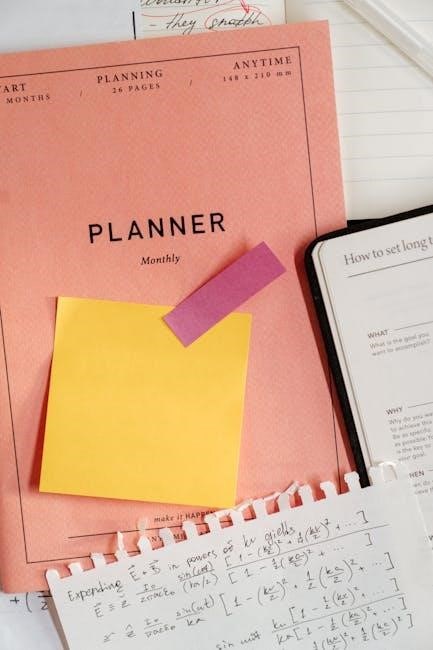IRS Form 990 Schedule M is used by tax-exempt organizations to report noncash contributions, ensuring transparency and compliance with IRS requirements. It helps detail donations like property or goods received, aiding in accurate financial disclosures and public accountability.
1.1 Overview of Schedule M
Schedule M is a supporting schedule for IRS Form 990, used by tax-exempt organizations to report noncash contributions. It provides detailed information about donated property, goods, or services, ensuring transparency in financial disclosures. The schedule includes columns for checking applicability, the number of contributions, property descriptions, and valuation methods. It helps organizations accurately document and disclose noncash donations, aiding in compliance with IRS regulations and public accountability. Proper completion of Schedule M is essential for organizations receiving significant noncash contributions, as it ensures adherence to reporting requirements and avoids potential issues during IRS reviews.
1.2 Importance of Noncash Contributions Reporting
Accurate reporting of noncash contributions is crucial for tax-exempt organizations to maintain transparency and comply with IRS regulations. Noncash donations, such as property or goods, often represent significant value and must be properly documented to ensure accountability. Schedule M provides a structured format for detailing these contributions, helping organizations avoid penalties and demonstrate compliance; Reporting noncash contributions also aids in public scrutiny, as donors and the public can review financial disclosures. Additionally, it ensures fair valuation methods are used, which is essential for maintaining trust and meeting IRS requirements for noncash gifts.

Purpose and Scope of Schedule M
Schedule M is required for organizations receiving noncash contributions exceeding $25,000, ensuring detailed reporting of such donations to maintain compliance and transparency with IRS regulations.
2.1 Definition of Noncash Contributions
Noncash contributions refer to donations of goods, services, or property rather than monetary funds. Examples include inventory, real estate, artwork, or equipment. These contributions are recorded at their fair market value, ensuring accurate financial reporting. Noncash donations are essential for tax-exempt organizations, as they support operations and missions without direct cash inflows. Proper valuation and documentation are critical to comply with IRS regulations and maintain transparency in financial disclosures. Understanding this definition is key to accurately completing Schedule M and meeting IRS requirements for noncash contribution reporting.
2.2 Types of Property Covered Under Schedule M
Schedule M requires reporting on various types of noncash contributions, including artwork, inventory, real estate, vehicles, securities, and intellectual property. Each category must be documented with its fair market value. For example, donated goods like clothing or furniture fall under inventory, while land or buildings are classified as real estate. The IRS specifies that certain types of property, such as stock options or services, are not reportable under Schedule M. Organizations must carefully categorize contributions to ensure accurate reporting and compliance with IRS guidelines, avoiding common mistakes in classification.

Eligibility Criteria for Filing Schedule M
Organizations must file Schedule M if they received noncash contributions exceeding $25,000 during the tax year. This ensures transparency and compliance with IRS reporting standards.
3.1 Threshold for Filing Schedule M
The threshold for filing Schedule M is determined by the total value of noncash contributions received during the tax year. Organizations must file Schedule M if their noncash contributions exceed $25,000. This includes donations of property, goods, or services, valued at their fair market worth. The $25,000 threshold applies to the aggregate value of all noncash items received, not per contribution. This requirement ensures transparency and accountability for tax-exempt organizations. Accurate reporting of these contributions is essential for compliance with IRS regulations and maintaining public trust in the organization’s financial dealings.
3.2 Organizations Required to File Schedule M
Organizations required to file Schedule M include those that file Form 990 and receive noncash contributions exceeding the $25,000 threshold. This applies to charities, foundations, and other tax-exempt entities. Schedule M must be attached to Form 990 if the organization answers “Yes” to Part IV, lines 29 or 30. It ensures transparency in reporting noncash donations, such as property, goods, or services. Filing Schedule M is mandatory for organizations meeting the criteria, while those below the threshold may still report noncash contributions on Form 990 without completing Schedule M.

Instructions for Completing Schedule M
Instructions for Schedule M guide organizations through columns (a)-(d), detailing how to report noncash contributions accurately, ensuring compliance with IRS requirements and clear financial disclosure.
4.1 Understanding the Columns in Schedule M
Understanding the columns in Schedule M is crucial for accurate reporting. Column (a) requires a check if the type of property applies. Column (b) asks for the number of contributions received. Column (c) demands a detailed description of the property donated. Column (d) specifies the method used to determine the fair market value of the contribution. Each column serves a distinct purpose, ensuring comprehensive disclosure of noncash contributions. Properly filling out these columns helps organizations meet IRS requirements and maintain transparency in their financial reporting. Accuracy in each column is vital for compliance and avoiding potential audits or penalties.
4.2 Column (a): Check if Applicable
Column (a) in Schedule M requires a simple checkmark to indicate whether the specific type of property applies to the organization. This column helps categorize contributions by type, such as artwork, securities, or real estate. By checking the box, organizations affirm that they received contributions of that particular property type during the tax year. It is essential to review each property category carefully to ensure accurate reporting. This step aids in organizing contributions and simplifies the disclosure process, ensuring compliance with IRS guidelines. Proper use of Column (a) sets the foundation for detailed reporting in subsequent columns. Accuracy here is critical to avoid mismatches in later sections.
4.3 Column (b): Number of Contributions
Column (b) in Schedule M requires organizations to enter the number of contributions received for each type of property listed. This column focuses on the quantity of contributions rather than their monetary value. For example, if an organization received three pieces of artwork, the number “3” would be entered in Column (b) under the artwork category. It is important to accurately count each contribution to ensure transparency and compliance with IRS reporting standards. This data helps the IRS and the public understand the scope of noncash donations the organization has received during the tax year. Precision is key to avoid reporting errors.
4.4 Column (c): Description of Property
Column (c) requires a clear and concise description of each type of property contributed. This helps identify the nature of the noncash contributions, such as “artwork,” “vehicles,” or “equipment.” The description should be specific enough to avoid ambiguity but does not need to be overly detailed. For example, describing “used furniture” rather than just “furniture” provides clearer context. The goal is to ensure transparency and allow the IRS and the public to understand the types of property received. Accuracy in this column is crucial for proper reporting and compliance with IRS guidelines. Ensure descriptions align with the categories listed in Column (a).
4.5 Column (d): Method of Determining Amount
Column (d) requires organizations to specify the method used to determine the fair market value or amount of noncash contributions. Common methods include appraisals, market value comparisons, or cost basis. For example, if artwork was valued using an independent appraisal, this should be noted. If the value was based on the donor’s cost or comparable sales, that should also be specified. This column ensures transparency in how the organization arrived at the reported value, providing clarity for the IRS and the public. Accurate documentation is essential to support the methods listed in this column. Proper compliance avoids potential IRS scrutiny.

Reporting Requirements for Noncash Contributions
Organizations must report noncash contributions in detail, including the type of property and its fair market value. Compliance with IRS guidelines ensures accurate and transparent disclosure.
5.1 Detailed Reporting for Each Type of Property
For each type of property received, organizations must provide detailed information, including descriptions, quantities, and methods used to determine fair market value. This ensures clarity and compliance with IRS standards.

5.2 Aggregating Contributions and Fair Market Value
Organizations must aggregate noncash contributions by type and report the total fair market value. For contributions exceeding $500, detailed reporting is required, including descriptions and valuation methods. Accurate determination of fair market value ensures compliance with IRS standards. Proper aggregation helps in summarizing contributions without omitting significant details. This step is crucial for transparent financial reporting and meeting IRS requirements for noncash donations. Ensure all values align with IRS guidelines to avoid discrepancies and maintain compliance.

Compliance and Due Diligence
Adherence to IRS guidelines is crucial for accurate reporting of noncash contributions. Proper documentation and thorough reviews ensure compliance, minimizing risks of errors or discrepancies in Schedule M filings.
6.1 Documentation and Record-Keeping
Accurate and detailed documentation is essential for compliance with IRS Schedule M requirements. Organizations must maintain records of noncash contributions, including receipts, appraisals, and descriptions of donated property. Proper documentation ensures that all reported information is verifiable and aligns with IRS guidelines. Records should include details such as the donor’s name, date of contribution, and method of determining fair market value. Failure to maintain adequate records can lead to discrepancies and potential penalties. Organizations should also retain documentation for at least three years in case of an audit. Organized and thorough record-keeping simplifies the reporting process and ensures transparency.
6.2 IRS Review and Audit Procedures
The IRS reviews Schedule M to ensure compliance with reporting requirements for noncash contributions. Audits may occur if discrepancies or inaccuracies are detected. Organizations must be prepared to provide detailed documentation, including appraisals and donor records, to support reported values. Penalties may apply for underreporting or overvaluation of contributions. The IRS uses specialized procedures to verify fair market values and assess compliance. Timely and accurate responses to audit inquiries are crucial to avoid prolonged scrutiny. Organizations should maintain organized records and seek professional advice to navigate audit processes effectively, ensuring transparency and adherence to IRS guidelines throughout the review.

Common Mistakes to Avoid When Filing Schedule M
Common mistakes include incomplete or inaccurate reporting of noncash contributions and failure to follow IRS guidelines, resulting in penalties or delays.
7.1 Incomplete or Inaccurate Reporting
One of the most frequent mistakes when filing Schedule M is providing incomplete or inaccurate information. Organizations often fail to check Column (a) when applicable or misclassify contributions. Incorrect descriptions in Column (c) and improper valuation methods in Column (d) are common errors. Additionally, failing to aggregate contributions correctly or not reporting fair market values accurately can lead to discrepancies. Such oversights may result in IRS scrutiny, penalties, or delays in processing. Ensuring thorough documentation and double-checking each entry is crucial to maintaining compliance and avoiding potential issues. Accurate reporting is essential for transparency and fulfilling tax-exempt obligations effectively.
7.2 Failure to Follow IRS Guidelines
Failure to adhere to IRS guidelines when completing Schedule M can lead to significant compliance issues. Organizations must strictly follow the instructions for each column, ensuring accurate descriptions and proper valuation methods. Misclassifying contributions or ignoring specific reporting requirements can trigger IRS audits or penalties. Additionally, not adhering to the IRS-defined thresholds for filing Schedule M can result in delays or rejection of the form. It is crucial to thoroughly understand and follow all IRS guidelines to avoid complications and maintain compliance with tax-exempt reporting obligations. Proper adherence ensures transparency and upholds the organization’s accountability to stakeholders and the public.

Best Practices for Preparing Schedule M
Consult IRS resources and guidelines to ensure accuracy. Maintain detailed documentation for all noncash contributions. Seek professional assistance for complex valuations or reporting requirements.
8.1 Consulting IRS Resources and Guidelines
Consulting IRS resources and guidelines is essential for accurately preparing Schedule M. The IRS provides detailed instructions online, including specific guidance for noncash contributions. Access the official IRS website for the latest forms, instructions, and publications related to Schedule M. Utilize tools like the “Instructions for Schedule M” and “Form 990 Instructions” to ensure compliance. Additionally, review IRS publications and notices for updates on noncash contribution reporting. Using these resources helps organizations understand reporting requirements, avoid errors, and ensure transparency. Regularly checking IRS updates also helps maintain compliance with evolving regulations.
8.2 Seeking Professional Assistance
Seeking professional assistance is highly recommended when preparing Schedule M, especially for complex cases. Tax professionals or legal experts specializing in nonprofit tax law can provide guidance tailored to your organization’s needs. They can help ensure compliance with IRS regulations, accurately determine fair market values, and properly classify noncash contributions. Professional assistance is particularly valuable for organizations with significant or unusual noncash donations, as errors can lead to audits or penalties; Additionally, consultants can offer insights into best practices for documentation and reporting, ensuring transparency and accuracy in your filings. Their expertise can save time and reduce the risk of errors.

IRS Resources and Additional Information
Visit the IRS website at www.irs.gov for the latest instructions, guides, and resources on Schedule M. This ensures accurate filing and understanding of all requirements.
9.1 Accessing Schedule M Instructions Online
To access Schedule M instructions, visit the IRS website at www.irs.gov/forms-instructions. Navigate to the Form 990 section and download the specific Schedule M guidance. Ensure to review the latest updates and detailed explanations to comply with reporting requirements accurately. Utilize the search function on the IRS site for quick access to related resources and forms. This ensures organizations have the most current information to prepare and file Schedule M correctly.
9.2 IRS Contact Information for Support
For assistance with IRS Form 990 Schedule M, visit the IRS website at www.irs.gov or call the IRS Exempt Organizations hotline at 1-877-829-5500. Phone support is available Monday through Friday, 7:00 a.m. to 7:00 p.m. local time. You can also find additional resources, such as forms, instructions, and FAQs, on the IRS website. For written inquiries, mail your questions to the IRS address listed on the Form 990 instructions. The IRS provides comprehensive support to help organizations navigate the filing process and ensure compliance with all requirements.
Accurate reporting on Schedule M is crucial for compliance. Ensure all noncash contributions are properly documented and valued. Stay informed about IRS updates to maintain adherence to regulations.
10.1 Ensuring Compliance and Accuracy
Ensuring compliance and accuracy when filing IRS Form 990 Schedule M is critical to avoid penalties and maintain organizational integrity. Double-check all reported noncash contributions for completeness and correctness. Verify fair market values using qualified appraisals where required. Ensure proper documentation, such as receipts and appraisals, is maintained. Adhere strictly to IRS guidelines for reporting methods and thresholds. Regularly review IRS instructions and seek professional advice if unsure. Accuracy in reporting not only prevents audits but also upholds transparency and trust in your organization’s financial disclosures.
10.2 Staying Informed About IRS Updates
Staying informed about IRS updates is essential for accurate and compliant filing of Schedule M. Regularly visit the IRS website at www.irs.gov to access the latest instructions and forms. Subscribe to IRS newsletters and follow tax-exempt organization resources to stay updated on rule changes. Utilize the News feature under the search bar for relevant articles and updates. Additionally, consult IRS publications or attend workshops to ensure familiarity with new regulations. Proactively seeking updated information helps organizations maintain compliance and avoid potential issues with noncash contribution reporting.

